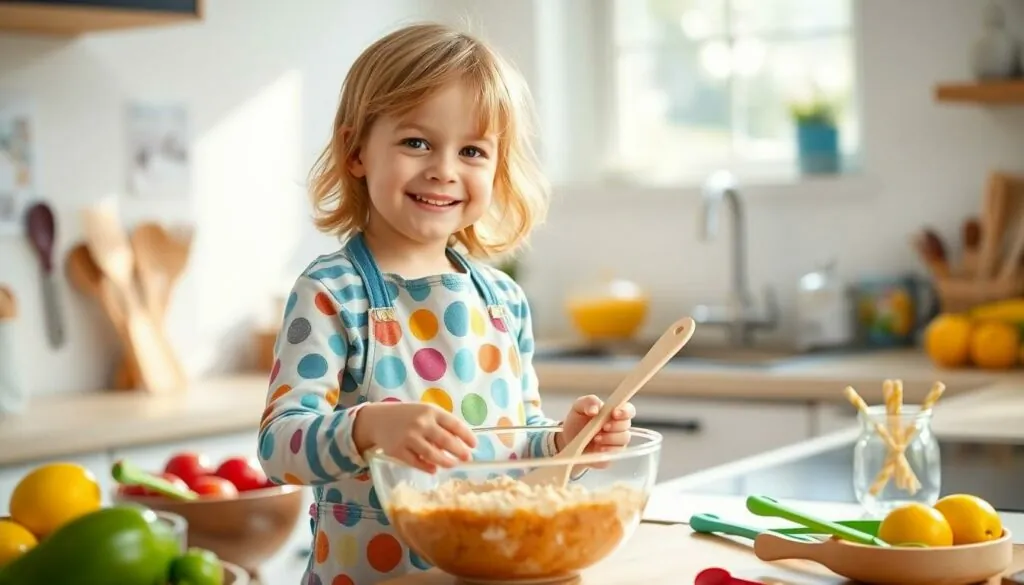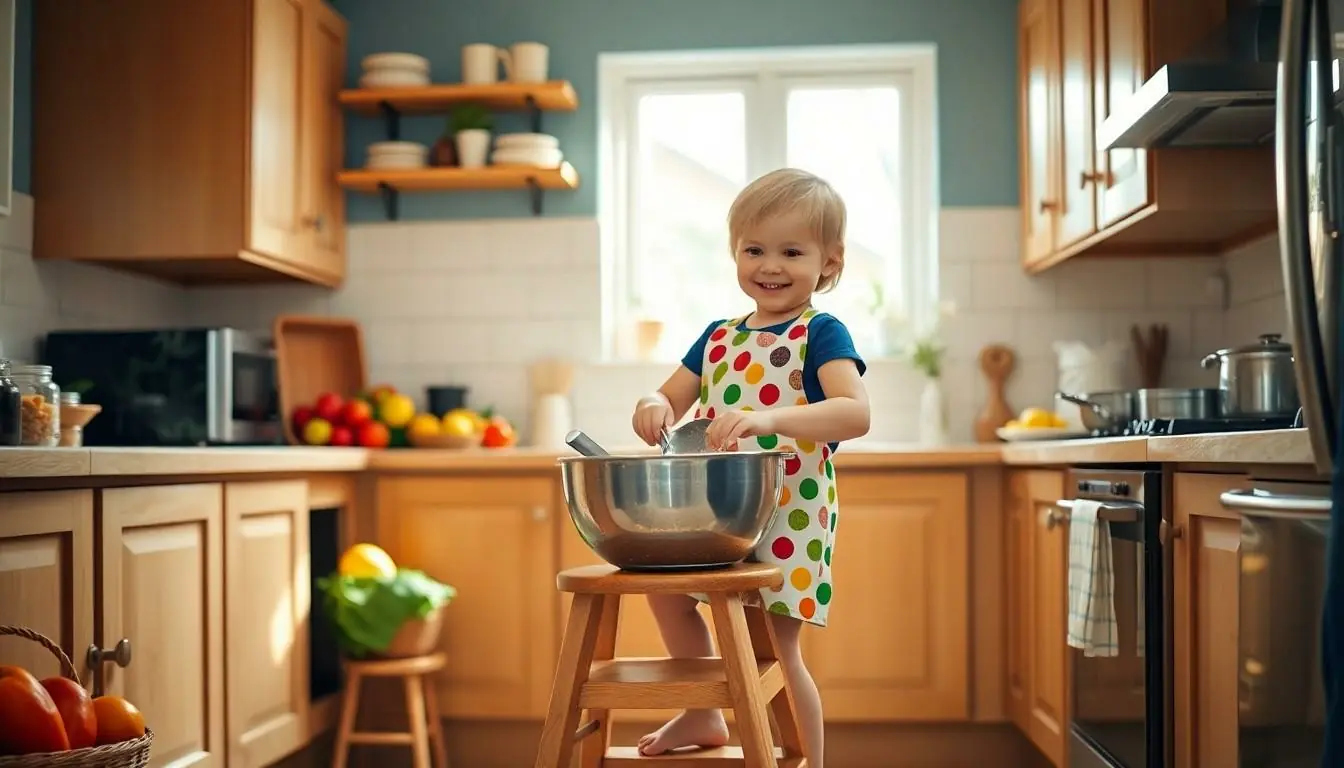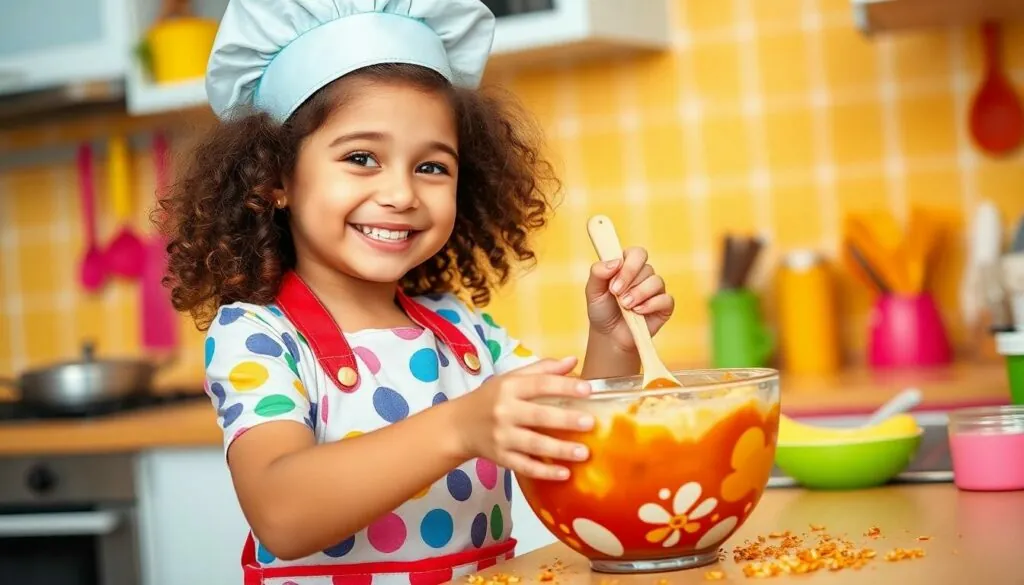Table of Contents
ToggleTeaching kids to cook isn’t just about creating future master chefs – it’s about building confidence skills and making memories that’ll last a lifetime. A well-designed cookbook for children can transform kitchen chaos into delicious family fun while sneaking in valuable life lessons along the way.
From measuring ingredients to mixing batters kids’ cookbooks open up a world of culinary adventures that go beyond basic mac and cheese. These specially crafted guides feature kid-friendly recipes safety tips and colorful illustrations that make cooking feel like an exciting treasure hunt rather than a chore. Whether they’re learning to crack eggs without creating a mess or discovering why cookies spread in the oven young chefs develop essential skills that’ll serve them well beyond the kitchen counter.
Benefits of Cooking With Kids
Cooking with kids creates memorable experiences while teaching valuable life lessons. The kitchen transforms into an interactive classroom where children develop essential skills through hands-on learning.
Building Confidence in the Kitchen
Children gain confidence through mastering cooking tasks like measuring flour measuring cups cracking eggs into bowls. Small achievements in recipe completion boost their self-esteem especially when they serve their creations to family members. Kids who participate in meal preparation demonstrate increased willingness to try new foods. The kitchen environment provides opportunities for problem-solving as children learn to follow instructions adapt to changes calculate measurements experiment with ingredients.
Learning Life Skills Through Cooking
Kitchen activities strengthen fundamental math skills through measuring counting portioning ingredients. Kids develop reading comprehension by following recipes interpreting instructions understanding cooking terminology. Time management emerges naturally as children learn to coordinate multiple tasks monitor cooking times plan meal preparation sequences. The kitchen introduces concepts of organization cleanliness food safety proper ingredient storage. Children practice teamwork communication skills while working alongside adults or siblings during meal preparation.
Essential Safety Guidelines for Kid Chefs
Teaching children kitchen safety establishes a foundation for confident cooking while preventing accidents. Creating a secure cooking environment enables young chefs to explore culinary skills safely.
Age-Appropriate Kitchen Tasks
Children ages 3-5 excel at simple tasks like washing produce mixing dry ingredients pouring pre-measured items. Kids ages 6-8 handle measuring ingredients cracking eggs spreading toppings kneading dough. Ages 9-11 master peeling vegetables using a microwave following basic recipes independently. Children 12+ operate small appliances cut with supervision cook at the stove.
| Age Group | Safe Kitchen Tasks |
|---|---|
| 3-5 years | Washing mixing pouring |
| 6-8 years | Measuring cracking kneading |
| 9-11 years | Peeling microwaving basic recipes |
| 12+ years | Cutting supervised cooking |
Kitchen Safety Rules
Proper hand washing prevents contamination when handling food. Sharp tools stay in designated areas away from counter edges. Pot handles turn inward on the stove to prevent spills. Heat-resistant oven mitts protect hands from burns. Long hair stays tied back loose clothing stays secured. Clean spills immediately to avoid slips. A step stool provides stable height for reaching counters. First aid supplies remain easily accessible. Adult supervision continues until children demonstrate consistent safety practices.
| Safety Equipment | Purpose |
|---|---|
| Oven mitts | Prevent burns |
| Step stool | Safe reaching |
| First aid kit | Emergency care |
| Hair ties | Food safety |
Best Cooking With Kids Cookbooks
Kid-friendly cookbooks transform kitchen time into an engaging learning experience with step-by-step instructions and colorful illustrations. These specialized cookbooks combine education with entertainment to make cooking accessible and fun for young chefs.
Beginner-Friendly Recipe Collections
The “America’s Test Kitchen Kids Cookbook” features 100+ tested recipes with detailed visual guides for basic cooking techniques. “The Complete Cookbook for Young Chefs” includes 150 recipes rated by 750 kids with easy-to-follow photo instructions. “Kids Cooking: Students Prepare and Eat Foods from Around the World” introduces global cuisine through 50 simple recipes perfect for beginners. Each recipe comes with safety tips, ingredient substitutions and achievement badges to track progress. These cookbooks incorporate large print text, measurement conversions and kitchen vocabulary lessons to build confidence in young cooks.
Educational Cookbooks for Different Ages
Age-specific cookbooks address developmental abilities through graduated skill levels. “Cooking Class: 57 Fun Recipes Kids Will Love to Make” targets ages 6-12 with recipes organized by difficulty. “The Cookbook for Kids” serves ages 8-13 with 60 recipes incorporating math skills through fractions and measurements. “Teen Kitchen” engages ages 13+ with advanced techniques like knife skills and kitchen science experiments. These books include nutritional information, food origin facts and culinary vocabulary to expand knowledge while cooking. Each recipe indicates required adult supervision levels based on cooking methods and equipment used.
Fun and Easy Starter Recipes
Kid-friendly starter recipes build confidence in young chefs with achievable culinary tasks. These beginner-level recipes create successful cooking experiences through simple techniques.
No-Bake Recipes for Young Children
No-bake recipes give children a safe introduction to kitchen skills without heat exposure. Kids create tasty treats like chocolate-covered banana bites grape caterpillars peanut butter balls with minimal equipment. Young chefs learn measuring stirring spreading rolling skills through recipes that take 15-30 minutes to complete. Popular no-bake options include:
- Fruit kebabs with colorful melon strawberries grapes
- Trail mix combinations using cereals dried fruits nuts
- Yogurt parfaits layered with granola berries honey
- Rice crispy treats mixed with marshmallows butter cereal
- Sandwich roll-ups filled with cream cheese vegetables meats
Simple Baking Projects
- Drop cookies using premeasured ingredients minimal steps
- Mini pizza rounds topped with sauce cheese vegetables
- Breakfast muffins incorporating fruits nuts chocolate chips
- Simple bread rolls shaped decorated by small hands
- Sheet pan brownies mixed measured poured by kids
| Recipe Type | Prep Time | Ingredients | Age Range |
|---|---|---|---|
| No-Bake | 15-30 min | 3-5 items | 4-8 years |
| Simple Baking | 30-45 min | 5-7 items | 6-12 years |
Kitchen Tools and Equipment for Kids
Creating a child-friendly kitchen environment starts with selecting the right tools designed for small hands. These specialized items enhance safety while building confidence in young chefs.
Child-Safe Cooking Utensils
Child-safe cooking utensils feature rounded edges, non-slip handles, and durable materials designed for small hands. Popular options include nylon-coated knives, mini whisks, silicone spatulas, and plastic mixing bowls that resist breaking. Measuring tools come in bright colors with large numbers, making it easy for children to read measurements accurately. Kid-sized rolling pins feature textured handles for better grip control, while child-friendly peelers include finger guards to prevent cuts. Manufacturers like OXO Tot and Curious Chef produce dedicated lines of kitchen tools specifically engineered for children ages 4-12.
Must-Have Kitchen Accessories
Essential kitchen accessories for young chefs include adjustable aprons with water-resistant materials, non-slip step stools with safety rails, and heat-resistant oven mitts sized for small hands. Silicone baking mats provide safe surfaces for rolling dough while preventing slipping. Timer devices with large digital displays help children track cooking times independently. Storage containers with snap-lock lids allow kids to safely store ingredients. Cleanup tools include child-sized cleaning brushes, small spray bottles for water, and lightweight dustpans. Cookie cutters in various shapes transform basic recipes into engaging projects while teaching shape recognition.
Teaching Kitchen Skills Through Recipes
Kid-friendly cookbooks transform basic kitchen tasks into engaging learning opportunities through structured recipes that build fundamental cooking abilities. These recipes serve as practical guides for developing essential culinary skills in a safe controlled environment.
Basic Measuring and Mixing
Measuring ingredients accurately forms the foundation of successful cooking with children. Kids learn to distinguish between dry and liquid measurements using tools like measuring cups spoons graduated cylinders. The process teaches mathematical concepts as children add 1⁄4 cups 1⁄2 teaspoons or double recipe quantities. Common mixing techniques include:
- Folding delicate ingredients into batters (egg whites meringues)
- Stirring wet dry ingredients together (pancake cookie dough)
- Whisking liquids to combine (eggs milk dressings)
- Kneading dough with proper pressure technique (bread pizza)
A kitchen scale introduces precise weight measurements helping children understand volume mass relationships while developing motor control coordination.
Simple Knife Skills for Kids
Safe knife handling begins with age-appropriate tools designed specifically for young chefs. Children ages 7+ start with nylon-coated knives plastic lettuce knives butter knives to practice basic cutting techniques:
- Slicing soft fruits vegetables (bananas cucumbers)
- Spreading ingredients (butter peanut butter)
- Creating simple garnishes (orange wedges apple slices)
- Chopping herbs leafy greens (parsley basil)
Key safety rules include:
- Keep fingers tucked away from blade
- Cut on stable surfaces using non-slip cutting boards
- Move slowly deliberately with each cut
- Clean store knives properly after use
Adult supervision remains essential during all knife activities regardless of skill level.
Making Cooking Educational and Fun
Cooking activities transform kitchen time into interactive learning experiences for children. Educational elements blend seamlessly with culinary tasks to create engaging opportunities for skill development.
Incorporating Math and Science
The kitchen serves as a natural laboratory for mathematical concepts through measuring ingredients. Children practice fractions while using measuring cups for liquids or dry goods. Multiplication skills develop when doubling recipes, while division comes into play when reducing portions. Temperature readings introduce scientific principles as kids monitor oven settings or watch water boil at 212°F. Chemical reactions become visible during baking processes as children observe how ingredients transform – such as eggs coagulating or baking soda creating bubbles in cookie dough.
Creative Recipe Modifications
Recipe adaptations encourage children to explore flavors while developing critical thinking skills. Kids experiment with ingredient substitutions by swapping chocolate chips for nuts or using different fruit combinations in muffins. Color variations emerge through natural food dyes like beet juice for pink frosting or spinach powder for green pasta. Texture exploration happens when children create unique toppings for pizzas or customize sandwich fillings. Shape modifications add excitement as children cut cookies into stars or arrange vegetable pieces into faces on plates.
Conclusion
A kids’ cookbook is more than just a collection of recipes – it’s a gateway to valuable life skills and cherished family moments. By choosing the right cookbook parents can create a safe engaging environment where children develop confidence math skills and creativity through hands-on cooking experiences.
With age-appropriate recipes safety guidelines and specially designed tools young chefs can embark on culinary adventures that’ll shape their relationship with food and cooking for years to come. These cookbooks serve as trusted guides helping transform kitchen time into an educational playground where memories are made one recipe at a time.




